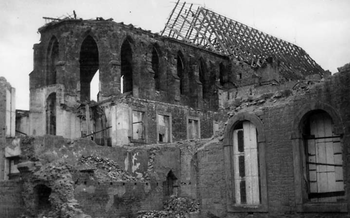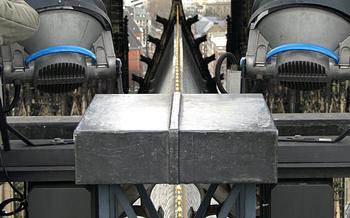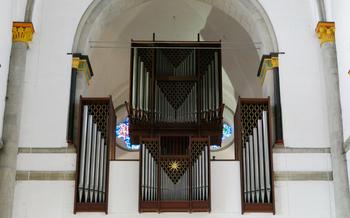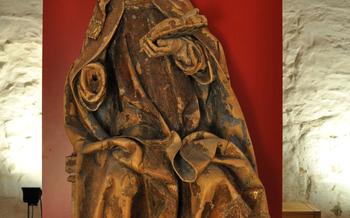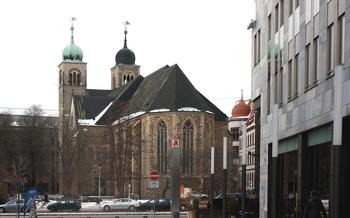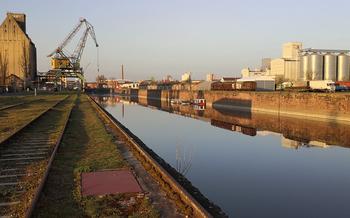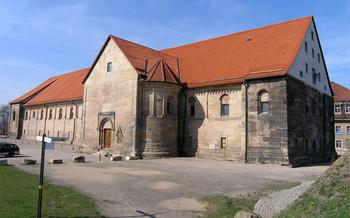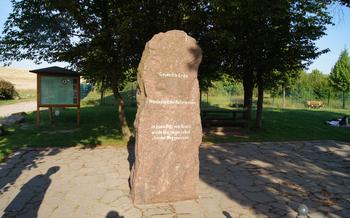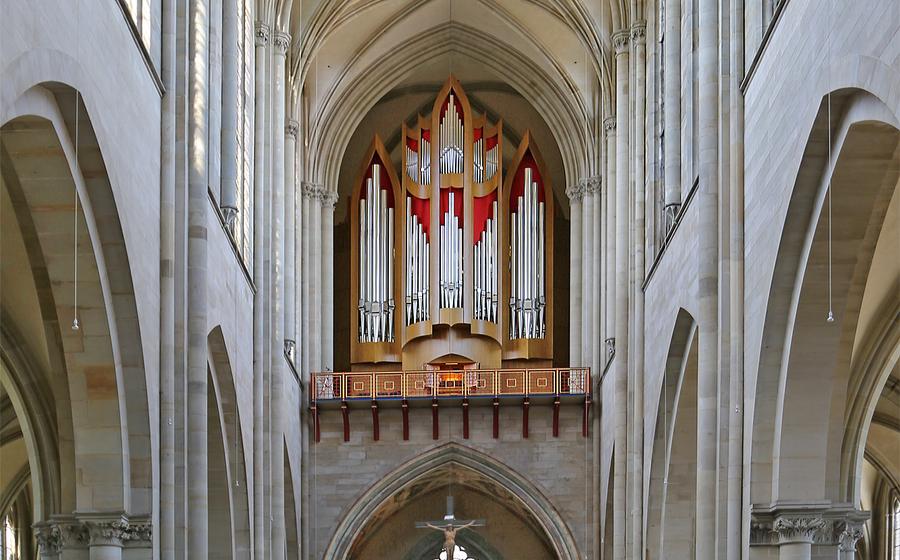
Magdeburger Dom (Magdeburg Cathedral)
- Magdeburg Cathedral: Symbol of Power and Faith
- A Journey Through Time: The Cathedral's History
- Architectural Marvel: Exploring the Cathedral's Exterior
- Stepping Inside: Unveiling the Cathedral's Interior
- The Power of Faith: Religious Significance
- Witnessing History: Notable Events
- The Sound of Music: The Cathedral's Organs
- A Place of Remembrance: Tombs and Epitaphs
- The Cathedral Museum: A Treasure Trove of History
- Magdeburg Cathedral in Popular Culture
- Practical Information for Visitors
- Unforgettable Experiences: Events and Services
- Capture the Moment: Photography Tips
- Local Delights: Where to Eat Nearby
- Insider Tip: Hidden Gem
Magdeburg Cathedral: Symbol of Power and Faith
In the heart of Magdeburg, Germany, stands a majestic edifice that has witnessed centuries of history and faith - the Magdeburger Dom or Magdeburg Cathedral. A testament to architectural prowess and religious devotion, the cathedral serves as an iconic landmark of the city, drawing visitors and pilgrims alike.
Historical Significance The history of Magdeburg Cathedral is deeply intertwined with the rise and fall of empires. It was founded in the 10th century by Otto I, the first Holy Roman Emperor, as a symbol of his power and authority. Throughout the Middle Ages, the cathedral served as a center of religious and political life, hosting imperial coronations and important church councils.
Architectural Features Magdeburg Cathedral is a prime example of Romanesque and Gothic architecture. Its imposing facade features intricate sculptures and carvings, while its twin towers soar high above the city skyline. The interior of the cathedral is equally impressive, boasting a spacious nave, stunning stained glass windows, and elaborate choir stalls.
Religious Importance As the seat of the Magdeburg Archdiocese, the cathedral holds significant religious importance. It is a center of Catholic worship, drawing thousands of pilgrims each year. The cathedral's numerous altars and chapels provide a sacred space for prayer and contemplation.
Location in the City Magdeburg Cathedral is strategically located in the heart of the city, adjacent to the Elbe River and surrounded by historic buildings. This central position reflects its importance as a religious and cultural landmark, making it an essential destination for visitors exploring Magdeburg.
A Journey Through Time: The Cathedral's History
Magdeburg Cathedral's rich history spans over a millennium, unfolding like a tapestry woven with faith, power, and architectural transformations. Its foundation dates back to the 10th century, when Otto I, the first Holy Roman Emperor, commissioned its construction as a symbol of his power and devotion. The original Romanesque basilica, completed in 973, showcased a simple yet majestic design.
In the 13th century, a Gothic transformation swept through the cathedral, infusing it with an ethereal elegance. The nave was extended, and graceful pointed arches replaced the sturdy Romanesque columns. This transformation reflected the city's growing wealth and the influence of the Gothic architectural style, which was gaining popularity throughout Europe.
The cathedral stood as a testament to Magdeburg's prosperity until the fateful night of January 16, 1945, when Allied bombs reduced it to ruins. The once-glorious edifice lay in smoldering rubble, a poignant symbol of the destruction wrought by war.
However, the spirit of Magdeburg and its cathedral remained unyielding. In the years that followed, a meticulous reconstruction effort was undertaken, guided by the original plans and remaining fragments. The cathedral rose from the ashes like a phoenix, its grandeur restored and its historical significance preserved for future generations.
Architectural Marvel: Exploring the Cathedral's Exterior
The imposing facade of Magdeburg Cathedral immediately captures the attention of visitors with its grand scale and intricate details. Two mighty towers, each reaching over 100 meters high, dominate the skyline, symbolizing the cathedral's power and significance. The towers, adorned with delicate tracery and ornate pinnacles, offer breathtaking views of the city and the surrounding countryside.
The exterior of the cathedral is a testament to the skill and artistry of medieval craftsmen. Sculptural decorations abound, depicting biblical scenes, saints, and mythical creatures. Look closely, and you'll find gargoyles peering down from the eaves, adding a touch of whimsy to the otherwise solemn facade.
Unique architectural elements set Magdeburg Cathedral apart from other Gothic masterpieces. The "Magdeburger Reiter," a bronze equestrian statue of Otto the Great, stands proudly in front of the cathedral, symbolizing the close connection between the cathedral and the Holy Roman Empire. The "Paradiesportal," or Paradise Portal, located on the south side of the cathedral, features exquisite carvings depicting the story of Adam and Eve, inviting visitors to contemplate the themes of sin and redemption.
Stepping Inside: Unveiling the Cathedral's Interior
Beyond the impressive facade of Magdeburg Cathedral lies an equally awe-inspiring interior. As you step through the grand entrance, you are greeted by a sense of serenity and grandeur. The spacious nave, bathed in soft light filtering through the stained glass windows, invites you to explore the cathedral's hidden treasures.
The nave is adorned with beautiful stained glass windows, each telling a unique story from the Bible. The vibrant colors and intricate designs captivate the eye, creating a mesmerizing kaleidoscope of light. The choir stalls, intricately carved from wood, are a testament to the skill and artistry of the cathedral's craftsmen. The stalls are adorned with delicate carvings depicting scenes from the lives of saints and biblical figures, adding to the cathedral's rich visual tapestry.
As you explore further, you may stumble upon hidden treasures tucked away in the cathedral's corners. A small chapel, dedicated to a particular saint or a noble family, might reveal a hidden altarpiece or a beautifully preserved fresco. These hidden gems offer a glimpse into the cathedral's rich history and the devotion of its patrons.
The Magdeburg Cathedral is not just a monument to architectural prowess but also a living testament to the power of faith. Its interior is a sacred space where countless generations have come to pray, seek solace, and celebrate their beliefs. Whether you are a believer or simply an admirer of history and art, stepping inside the Magdeburg Cathedral is an experience that will leave a lasting impression.
The Power of Faith: Religious Significance
Magdeburg Cathedral stands as the epitome of religious devotion and spiritual significance in the city. As the seat of the Magdeburg Archdiocese, it serves as the ecclesiastical center of the Catholic Church in the region, guiding and nurturing the spiritual lives of its faithful. Throughout history, the cathedral has been a place of pilgrimage, attracting believers from near and far who seek solace, guidance, and a deeper connection with their faith.
Beyond its role as a pilgrimage site, the cathedral is also a vibrant center of Catholic worship. Regular masses, prayer services, and religious ceremonies fill the cathedral with the sounds of devotion and the spirit of community. The cathedral's spacious nave, adorned with beautiful stained glass windows, creates an awe-inspiring atmosphere that invites contemplation and reflection.
The cathedral's ecumenical significance cannot be overlooked. It has served as a platform for interfaith dialogue and understanding, fostering harmony and cooperation among different religious communities. The cathedral's commitment to promoting religious tolerance and cooperation has made it a symbol of unity and peace in the region.
Witnessing History: Notable Events
The Magdeburger Dom has been the backdrop for numerous significant historical events, each leaving an indelible mark on its storied history. In the 10th century, the cathedral hosted the coronation of Otto I, the first Holy Roman Emperor, solidifying its status as a powerful symbol of imperial authority. Over the centuries, the cathedral served as a venue for important political gatherings and religious ceremonies, witnessing the ebb and flow of power and faith in the region.
One of the most notable events that took place within the cathedral walls was the signing of the Peace of Westphalia in 1648, a pivotal moment in European history that ended the devastating Thirty Years' War. The cathedral provided a sanctuary for peace negotiations, and its halls echoed with the voices of diplomats seeking to mend the wounds of war and usher in an era of religious tolerance.
In addition to its political and religious significance, the cathedral has also been a stage for cultural events and performances. Throughout the centuries, the cathedral's impressive acoustics have attracted renowned musicians and composers, who have graced its halls with their melodies. The cathedral's grand interior has also served as a backdrop for art exhibitions, theatrical performances, and other cultural events, showcasing the diverse talents of the region.
The Sound of Music: The Cathedral's Organs
Magdeburg Cathedral resonates with the majestic sounds of its historic organs, adding another dimension to its spiritual and cultural significance. Two magnificent organs grace the cathedral's interior, each with a unique story and captivating musical capabilities.
The main organ, known as the Schuke Organ, is a masterpiece of organ building. Constructed in 1969, it boasts over 5,000 pipes, ranging from delicate whispers to thunderous roars. The organ's impressive console features four manuals and a pedalboard, allowing organists to command a vast array of sounds and textures.
The smaller organ, situated in the cathedral's choir, is an equally impressive instrument. Built in 1938 by the renowned organ builder Friedrich Weißenborn, this organ is known for its warm and expressive tones. With its two manuals and pedalboard, it is perfectly suited for accompanying choral music and solo performances.
Throughout the year, the cathedral hosts a series of organ concerts, showcasing the talents of renowned organists from around the world. These concerts fill the cathedral's vast space with a symphony of sound, creating an unforgettable experience for music lovers and visitors alike.
The unique acoustics of the cathedral further enhance the organ's captivating sounds. The reverberant interior allows the music to linger and resonate, enveloping listeners in a rich and immersive soundscape. This acoustic phenomenon makes the cathedral an ideal venue for organ concerts and recordings.
Magdeburg Cathedral's organs are not merely musical instruments; they are integral to the cathedral's identity and spiritual atmosphere. Their majestic sounds accompany religious services, weddings, and other special occasions, adding solemnity and grandeur to these events. Whether you are a music enthusiast or simply seeking a moment of tranquility, the organs of Magdeburg Cathedral will leave an unforgettable impression.
A Place of Remembrance: Tombs and Epitaphs
Magdeburg Cathedral is the final resting place of numerous notable figures from history. Their tombs and epitaphs offer a glimpse into the lives and legacies of those who shaped the cathedral's history and the city of Magdeburg.
One of the most famous tombs is that of Otto I, the Great, the first Holy Roman Emperor. His impressive tomb, located in the cathedral's crypt, features a bronze effigy of the emperor in full regalia. Another notable tomb is that of Archbishop Wichmann von Seeburg, who played a crucial role in the cathedral's construction. His tomb, adorned with intricate carvings, is a testament to his contributions to the city.
The cathedral's walls are lined with epitaphs, each telling a unique story. These inscriptions commemorate bishops, priests, and other prominent individuals who served the cathedral and the community. Some epitaphs are simple and straightforward, while others are elaborate and poetic, offering insights into the lives and characters of the deceased.
One particularly poignant epitaph is that of a young woman named Anna, who died in childbirth. Her epitaph reads: "Here lies Anna, who gave her life for her child. May she rest in peace." Another epitaph, written in Latin, honors a priest who dedicated his life to helping the poor and sick. It reads: "He was a true shepherd to his flock, always caring for their needs."
These tombs and epitaphs serve as a reminder of the rich history and diverse characters that have graced Magdeburg Cathedral over the centuries. They offer visitors a chance to reflect on the lives of those who came before them and to appreciate the enduring legacy of this magnificent cathedral.
The Cathedral Museum: A Treasure Trove of History
The Magdeburg Cathedral Museum is a must-visit for anyone interested in delving deeper into the rich history and cultural significance of the cathedral. Located within the cathedral complex, the museum houses a fascinating collection of artifacts, exhibits, and artwork that shed light on the cathedral's past and its role in the religious and cultural landscape of Magdeburg.
Visitors can embark on a journey through time as they explore the museum's various displays. From medieval manuscripts and liturgical objects to stunning religious artworks, the museum offers a glimpse into the cathedral's history, its architectural evolution, and its religious traditions. Interactive exhibits and multimedia presentations bring the cathedral's story to life, making it accessible and engaging for visitors of all ages.
A highlight of the museum is the impressive collection of cathedral treasures. Visitors can admire intricate gold and silverwork, precious relics, and ornate vestments that were once used in religious ceremonies. These treasures offer a glimpse into the wealth and opulence of the cathedral during its heyday.
The museum also features a section dedicated to the cathedral's role in the Protestant Reformation. Visitors can learn about the impact of Martin Luther's teachings on the city of Magdeburg and the cathedral itself. The museum's collection includes rare books, pamphlets, and other artifacts that document this important period in the cathedral's history.
In addition to its permanent exhibits, the cathedral museum also hosts temporary exhibitions on various themes related to the cathedral and its history. These exhibitions often feature unique artifacts and artworks that are not normally on display, making them a special treat for visitors.
Whether you're a history buff, an art enthusiast, or simply curious about the role of religion in Magdeburg's past, the Magdeburg Cathedral Museum is a must-visit destination. It offers a unique opportunity to explore the rich heritage of this iconic landmark and gain a deeper understanding of its significance in the city's cultural and religious landscape.
Magdeburg Cathedral in Popular Culture
The grandeur and significance of Magdeburg Cathedral have transcended religious and historical boundaries, inspiring artists, writers, and filmmakers to incorporate it into their creative works. In literature, the cathedral has been featured in novels, poems, and historical accounts, capturing its essence and the rich tapestry of stories that surround it. Artistic representations of the cathedral abound, with paintings, sculptures, and engravings depicting its iconic spires and intricate details.
Magdeburg Cathedral has also graced the silver screen and television, appearing in documentaries, historical dramas, and even fantasy films. Its awe-inspiring architecture and historical significance have made it a sought-after location for filmmakers seeking to create visually stunning and authentic settings. Moreover, local legends and folklore are deeply intertwined with the cathedral, adding a touch of mystery and enchantment to its already captivating allure.
Practical Information for Visitors
Opening Hours: Magdeburg Cathedral is generally open to visitors daily, with specific hours for worship services and events. Visitors are advised to check the official website or contact the cathedral office for up-to-date information on opening times.
Admission Fees: Admission to the cathedral is free of charge, allowing visitors to explore the magnificent interior and admire its architectural wonders. However, there may be fees for specific guided tours or special events held within the cathedral.
Guided Tours: To enhance the visitor experience, guided tours are available in multiple languages, providing insightful commentary on the cathedral's history, architecture, and religious significance. These tours can be booked in advance or arranged upon arrival, depending on availability.
Accessibility: The cathedral is committed to inclusivity and accessibility for all visitors. It features ramps and elevators to facilitate access for those with mobility challenges, ensuring that everyone can explore and appreciate the cathedral's grandeur.
Unforgettable Experiences: Events and Services
Magdeburg Cathedral offers a plethora of enriching opportunities for visitors beyond its historical and architectural significance. Throughout the year, the cathedral hosts a variety of events and services that provide unique and unforgettable experiences.
Regular Church Services: For those seeking spiritual fulfillment and a sense of community, the cathedral offers regular church services where visitors can join in prayer, listen to uplifting sermons, and experience the sacred atmosphere of this magnificent space.
Special Events and Concerts: The cathedral frequently organizes special events and concerts that showcase its rich cultural heritage. These events range from classical music performances to choral concerts, art exhibitions, and seasonal celebrations. Visitors can immerse themselves in the cathedral's acoustics and enjoy a truly memorable experience.
Exhibitions and Workshops: For those interested in delving deeper into the cathedral's history and artistry, guided tours and exhibitions are offered. Visitors can learn about the cathedral's construction, restoration, and the fascinating stories behind its architectural features. Workshops are also held, providing hands-on experiences related to the cathedral's history and traditions.
Educational Programs: The cathedral recognizes the importance of educating future generations about its significance. Educational programs are organized for students of all ages, offering interactive sessions, guided tours, and workshops. These programs aim to instill an appreciation for the cathedral's rich history and cultural value.
Capture the Moment: Photography Tips
Magdeburg Cathedral's architectural grandeur and intricate details make it a photographer's paradise. To capture its essence, consider these tips:
-
Best Angles: Stand at a distance to capture the cathedral's full height and majesty. Experiment with different perspectives, such as shooting from below to emphasize its towering presence or from the side to showcase its length.
-
Lighting Conditions: Early morning or late afternoon light creates beautiful shadows and highlights, enhancing the cathedral's textures and architectural features. Avoid harsh midday light, which can result in flat images.
-
Composition Techniques: Use leading lines, such as the cathedral's twin towers or the arched doorways, to draw the viewer's eye into the image. Incorporate foreground elements, like statues or trees, to add depth and interest.
-
Capturing the Grandeur: To convey the cathedral's sheer size, use wide-angle lenses to exaggerate perspectives and create a sense of awe. Try shooting from a low angle to accentuate its height or use a telephoto lens to isolate specific details.
Local Delights: Where to Eat Nearby
After exploring the grandeur of the Magdeburg Cathedral, take a culinary journey through the city's diverse dining scene. Indulge in traditional German cuisine at cozy restaurants, where you can savor hearty dishes like schnitzel, bratwurst, and potato dumplings. For a taste of international flavors, venture into the city's vibrant neighborhoods, where you'll find everything from Italian trattorias to Asian fusion eateries.
If you're looking for a quick bite or a sweet treat, stop by one of Magdeburg's charming cafes or bakeries. Try the freshly baked breads, pastries, and cakes, or enjoy a cup of coffee while watching the world go by.
For a truly unforgettable dining experience, make sure to sample some of Magdeburg's local specialties. Don't miss the "Magdeburger Schmalzkuchen," a traditional pastry filled with sweet apple compote and sprinkled with cinnamon sugar. And for a taste of history, try the "Magdeburger Himmel und Erde," a dish made with mashed potatoes, apples, and blood sausage.
No matter what your taste buds desire, Magdeburg has something to offer. From traditional German fare to international cuisine and local delicacies, the city's dining scene is sure to tantalize your taste buds and leave you wanting more.
Insider Tip: Hidden Gem
Beyond its grand facade and well-known attractions, Magdeburg Cathedral holds secrets waiting to be discovered. Explore the hidden passageways that lead to secluded chambers and offer unique perspectives of the cathedral's architecture. Ascend to the panoramic viewing platform atop the towers for breathtaking vistas of the city and the surrounding countryside. Delve into lesser-known historical anecdotes, such as the legend of the "Magdeburg Riders," two bronze sculptures with a mysterious past. Uncover the stories behind the enigmatic symbols and carvings adorning the cathedral's walls, each whispering tales of faith, power, and intrigue. Embark on a journey of discovery, uncovering the hidden gems that make Magdeburg Cathedral a place of wonder and enchantment.

